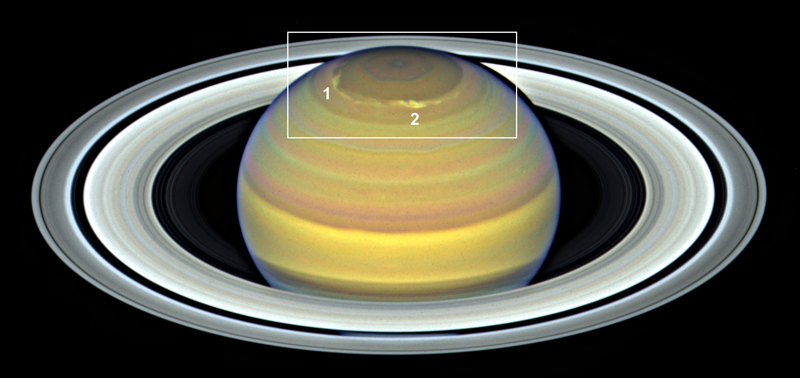If we look past Saturn’s rings, we see that the planet’s surface has few distinctive features. Most of the planet is made of hydrogen, helium, and such trace elements as ammonia, methane, and water, which create the planet’s visible bands and clouds.
Occasionally, however, Saturn’s surface lights up a bit with bright white spots. These are storms, formed when water clouds in the inner layers of the atmosphere—200 kilometers below the visible surface—heat up and rise, much like a summer storm anywhere on Earth but on a larger scale.
Until recently, researchers had observed just two types of Saturnian storms. The small ones, typically 2,000 kilometers in diameter, look like irregular bright clouds and last for a few days. The really big ones are known as great white spots. These are monster storms, up to 20,000 kilometers across—large enough to cover the entire Earth—that can persist for several months.
But in 2018, a new type of storm appeared on the surface of the ringed planet. Rather than a giant spot, four medium-sized storms appeared in sequence at slightly different latitudes near the north pole.
Identifying Midsized Storms
The first storm appeared on 29 March as a white blemish near the north pole of the planet, growing to a size of 2,000 kilometers across in just a few days. It stood alone, traveling westward at a speed of 220 kilometers per hour, until 25 May, when a second spot appeared. In August, two more storms joined the pair. Each storm appeared slightly to the north of the preceding one.

The storms moved at different speeds, probably under the influence of the local winds at their respective latitudes. This caused several close encounters. Every time they got close, the storms seemed to disrupt each other, causing them to sprout filaments that filled with dark and bright orbs, probably eddies that offered a brief glimpse at the lower layers of the atmosphere below the clouds. The first storm to appear was the longest lived, lasting for 214 days and reaching a maximum size of 4,000 kilometers across.
These interactions eventually altered an entire latitudinal band, turning it into a light-colored stripe near the north pole. The band persists today, even though the last storm disappeared in October 2018.
“This is something entirely new that we’ve never seen before.”
“This is something entirely new that we’ve never seen before,” said Agustin Sánchez-Lavega, a planetary scientist at University of the Basque Country in Spain. He is the first author of a study published in Nature Astronomy on 21 October describing the event.
Sánchez-Lavega highlights the contribution of amateur astronomers to this discovery. His university hosts a website called Planetary Virtual Observatory and Laboratory, where amateurs can contribute their planetary observations for research purposes.
In this case, the first indication that something was happening in Saturn’s atmosphere came from one of these images, captured by an amateur astronomer in Brazil. “As soon as I saw it, I knew it could be interesting, and we issued an alert for our community of amateur astronomers observing the gas giants,” explained Sánchez-Lavega. “This is very important because, thanks to them, we have daily images showing how the storm system has evolved.”
Sánchez-Lavega and his team also gathered observations from the Hubble Space Telescope and the 2.2-meter telescope in Calar Alto, Spain. They were also able to use images from Cassini, which crashed onto Saturn in September 2017 but had imaged the cyclonic vortex where the first storm originated. “This is a very unusual spot for a storm to originate,” Sánchez-Lavega explained.
The team members also used computer simulations to gauge the energy needed to generate the storms. They concluded that these were intermediate storms also in terms of energy, requiring about 10 times more energy to form than a typical small storm, but around 100 times less energy than great white spots.

Another Piece of the Saturnian Puzzle
Still, the team doesn’t know much about the mechanism that powers these and other storms on Saturn. Questions like why they appear at certain latitudes, why they’ve been observed only in the northern hemisphere, or why the great white spots seem to appear roughly every 60 years are open to debate.
“What this tells us is that there is a certain dynamic that occurs below the upper clouds that we see, known as the weather layer. This dynamic must happen at the base of the water cloud, 200 kilometers below the surface,” Sánchez-Lavega said.
“Discovering a third type of storm on Saturn will add yet another piece to the puzzle of Saturn’s intricate weather system.”
“Saturn’s atmosphere is a complex, dynamic environment with its own seasons and cycles, much like weather cycles on Earth but spanning decades rather than years,” said Cassini project scientist Linda Spilker, who wasn’t involved in the study. “Discovering a third type of storm on Saturn will add yet another piece to the puzzle of Saturn’s intricate weather system.”
According to Sánchez-Lavega, now that the Cassini mission is over, this is a good time to go back to the lab and focus on refining the computer models of Saturn’s atmosphere.
“We hope that the James Webb Space Telescope will allow us to see in the infrared how these storms and other phenomena occur, characterizing the chemical composition so we can feed it into the models,” Sánchez-Lavega said. “Our future research will focus [on understanding] the thermodynamic cycle of water in Saturn using observations from advanced telescopes like the James Webb.”
—Javier Barbuzano (@javibarbuzano), Science Writer
Citation:
Barbuzano, J. (2019), New type of storm spotted on Saturn, Eos, 100, https://doi.org/10.1029/2019EO136230. Published on 30 October 2019.
Text © 2019. The authors. CC BY-NC-ND 3.0
Except where otherwise noted, images are subject to copyright. Any reuse without express permission from the copyright owner is prohibited.

